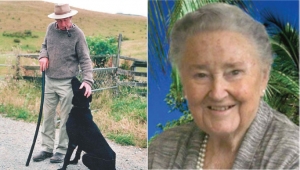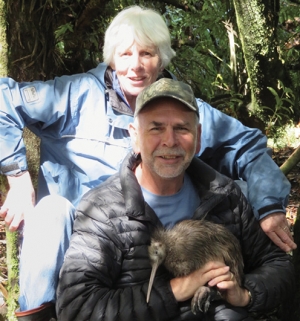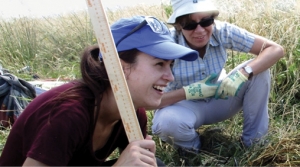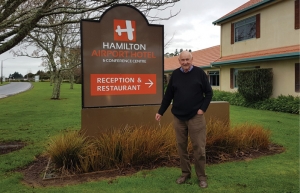Super User
Obituaries 2019
DUNZ farewells great supporter
Rob was a great supporter and always bid up well at our annual dinner and auctions, as well as donating Borthwick Wines. He farmed for most of his life at Wainuioru, east of Masterton, where he established several wetland areas.
He will be sorely missed. – Ross Cottle
Top seller kept raffles in profit
Hunt for the puweto
In Brief
Symposium in Napier
Other speakers are Australian ecologist Matt Herring and the new CEO for Fish & Game, Martin Taylor.
Forum seeks changes
The Land and Water Forum wants a new national body to oversee freshwater management to prevent the decline of wetlands and ‘outstanding water bodies’. Forum chair Dr Hugh Logan said, “A motivated effort at a national level is required to improve water quality. It will require better coordination and deployment of resources, which we believe should be delivered through a new Land and Water Commission.”
Environment Minister David Parker said some, but not all, of the forum’s recommendations would be adopted. Suggested changes to the RMA were not likely to be introduced to Parliament this year, he said.
Injured bittern found
A break from winter in BC
Ducks Unlimited Canada members Len and Pat Everett spent several months in New Zealand this year, partly to avoid winter at home in British Columbia. They visited the Whakamanu Wildlife Trust sanctuary at Manunui near Ruapehu and enjoyed helping out with a North Island brown kiwi’s health check-up. The Canadian couple visited several of our members and wetlands, and spent time fishing and playing golf, and helping their son and partner move into a home they had just bought in Wellington.
On their return home to Canada, Len was honoured with a special award at a DUC 80-50 Anniversary Celebration (80 years in Canada and 50 years in BC) for 30 years of service to DUC and the wetlands of BC.
Nurse trees give saplands a headstart
Stevie Waring has been looking into the benefits of nurse trees in wetlands restoration at Wairio.
Swamps are a category of wetland that are dominated by flood-tolerant trees, which thrive in soils that are nutrient-rich, but occasionally boggy or flooded.
Historically, New Zealand’s swamps were dominated by large podocarp trees,especially kahikatea andtotara, but these were targeted as valuable timber throughout the 19th century. Thereafter, land conversions for urban expansion and agriculture
continued to degrade swamps. A primary goal of wetland restoration is to revegetate sites with native trees.
However, up to 70 per cent of sapling trees can die within the first year of planting. The death of trees increases the financial costs of wetland restoration while reducing the benefits to nature and the morale of project participants. Put simply, dead trees reduce the feasibility of restoration of wetland swamps.
Nearby plants can affect the earlier years of a sapling’s life. For example, highly competitive perennial grasses can shade and outcompete the saplings for light and soil resources. On the other
hand, having neighbours may benefit the sapling.
In exchange for sugars made by the plant in photosynthesis, AMF provide the plant with soil nutrients. Because sapling establishment is influenced by nurse trees over such a wide range of site conditions, nurse effects may be particularly important for trees.
Little is known about how nurse trees affect establishing saplings in wetland restoration. Can strategically planting saplings near nurse trees increase their survival and growth rates? Or are other
site factors such as soil moisture more important for sapling survival?
In my MSc thesis, in the Centre for Biodiversity and Restoration
Ecology at Victoria University, I sought to identify how nurse
trees improve establishment of two podocarp tree species
planted as part of a wetland swamp forest restoration.
In collaboration with Ducks Unlimited and the Department of Conservation, I monitored the survival and growth of kahikatea
(Dacrycarpus dacrydioides) and totara (Podocarpus totara) saplings planted with or without an established nurse trees at the Wairio wetland. The wetland connects a large, ecologically, culturally and recreationally important wetland complex that spans the Wairarapa valley. However, the increased nutrient inputs from livestock and chemical fertilisers and the introduction of pasture plant species have led to a weed-dominated environment.
During restoration, highly competitive perennial grasses can shade and outcompete the newly planted, slowgrowing podocarps. In addition, the complex hydrology of the site leads to species-specific spatial patterns of mortality and growth.
In my studies, I tested whether the presence of a woody nurse tree
(manuka, pittosporum or coprosma) influenced the survival and growth of kahikatea and totara over the critical first year of establishment. I monitored soil moisture, the pH and oxygen status of soils, root-available nutrients, and soil carbon content under saplings planted with and without nurses. I also quantified the abundance of spores of AMF fungi under all saplings.
Six go wild in Santa Fe
Graham Gurr goes in search of a golden dorado.
Return they (the doves) did, thousands of them, an almost continuous stream of birds as far as the eye could see coming directly to the roost, which was now behind us. If the morning shoot had been good, this was sensational.
Predator Free New Zealand
Maybe - but not just yet
- aims for a sustainable yield
- never takes more individuals than the population can replace
- can be like the constant harvest by rabbit trappers, deer cullers, and predators
- a population can’t be affected if the yield is not declining.
- protection of a valued resource can be ineffective unless broader ecological/ sociological context is understood
- the interaction of resource/habitat/ people defines the outcome
- solutions require strategic organisation, stakeholders agreement and effective methods
- the biology and strategic organisation determine effective policy (which DU does very well).
- Forgetting that nature is on the predators’ side and ignoring the effects of natural selection
- Counting numbers removed, not numbers remaining,
- Lack of coordinated, agreed strategy
- Lack of flexibility in response to experience
- Insufficient stakeholder support.
- Inefficient tools
- Failing to deploy combination of methods
- Having no effect on fertility, immigration.
- Operator confidence, meticulous preparation, sufficient funding
- Never repeating mistakes, never giving up, so accumulating improvements, combining/switching strategies when necessary
- Landscape scale coordination
- Strong community support.
New technology
- Adds to natural mortality
- Prevents immigration
- Targets fertility
- Confirms benefit to native species.
Waipa wars – from muskets to mustelids
CONFERENCE REPORTS
Neil Candy reported that Jim Law had replaced Ken Cook as a trustee on the Waterfowl and Wetland Trust, which was “ticking along really well” with more than $500,000 in the bank.
Wetland Care
Reporting on the work of Wetland Care, Will Abel said $10,800 had been spent on three wetlands in the past year, creating about 10 acres of wetland
BITTERN
WAIRIO WETLAND
Decisive year ahead for Board
Where to from here will be the big question facing the DUNZ Board in the coming year. President Ross Cottle, in opening the formal business of the 44th AGM, said that, with an ageing membership and fewer members keen to do the work, the future direction of Ducks Unlimited would be on the Board’s agenda this year.
Measures already in place or under consideration were making Flight a two-yearly publication and changing the conference to a biennial event rather than yearly. With fewer demands to create new wetlands and maintain the established ones, the Board would be looking at other ways, including research scholarships, to support DUNZ’s goals.
Ross thanked John Cheyne, who resigned earlier in the year, for his four years as president and for raising the profile of bittern. Ross also paid tribute to those members who had passed away during the past year: Ian Pirani, Nancy Pain, Audrey Pritt, Alan Wilk and Robin Borthwick. Joyce Brooks also passed away after the AGM.
Treasurer John Bishop presented the accounts and updated members on the new rules for charitable trusts, which require entities to state their purpose. DUNZ had submitted the following mission statement: “We deliver and advocate for effective wetland restoration, development, research and education; and support the preservation of threatened waterfowl and the ethical and sustainable use of wetlands.”





